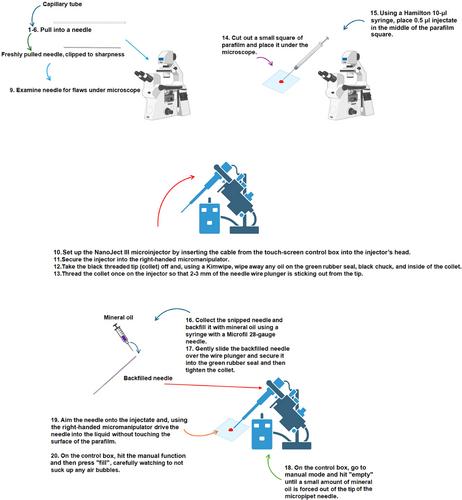下载PDF
{"title":"Injection of Ortho-Functionalized Tetrafluorinated Azobenzene-Containing siRNAs into Japanese Medaka Embryos for Photocontrolled Gene Silencing","authors":"Makenzie Mateus, Matthew L. Hammill, Denina B. D. Simmons, Jean-Paul Desaulniers","doi":"10.1002/cpz1.70051","DOIUrl":null,"url":null,"abstract":"<p>This article describes the detailed methodology of how to inject photoswitchable <i>ortho</i>-functionalized tetrafluorinated short interfering RNAs (F-siRNAs) into a single cell of stage-two Japanese medaka (<i>Oryzias latipes</i>) embryos and how to control gene silencing with different wavelengths of light. Many of the prior papers describing Japanese medaka embryo injections omit key information. As such, this article aims to give an in-depth explanation as to how the NanoJect III microinjector can be used for this purpose. To obtain the embryos for microinjection, adult medaka are housed under a 14-hr light, 10-hr dark cycle to mimic their natural breeding period. This induces mating at approximately the same time each day, when the lights turn on, so recently fertilized eggs can be obtained. Synthetic F-siRNAs are injected into transgenic stage-two single-cell Japanese medaka embryos expressing enhanced green fluorescent protein (eGFP). Our data demonstrate that our F-siRNAs can silence gene activity in Japanese medaka embryos expressing eGFP. Moreover, gene expression can be activated by exposing F-siRNA-injected embryos to blue light and deactivated a few days after exposure to green light. To the best of our knowledge, this marks the first reversible control of a gene-silencing oligonucleotide within an <i>in vivo</i> system. © 2024 The Author(s). Current Protocols published by Wiley Periodicals LLC.</p><p><b>Basic Protocol 1</b>: Medaka maintenance and embryo collection</p><p><b>Basic Protocol 2</b>: Injection of stage-two one-cell medaka embryos</p><p><b>Basic Protocol 3</b>: Evaluation of the F-siRNA gene-silencing ability through light activation and inactivation using blue and green light by measuring enhanced green fluorescent protein fluorescence</p>","PeriodicalId":93970,"journal":{"name":"Current protocols","volume":"4 11","pages":""},"PeriodicalIF":0.0000,"publicationDate":"2024-11-15","publicationTypes":"Journal Article","fieldsOfStudy":null,"isOpenAccess":false,"openAccessPdf":"https://onlinelibrary.wiley.com/doi/epdf/10.1002/cpz1.70051","citationCount":"0","resultStr":null,"platform":"Semanticscholar","paperid":null,"PeriodicalName":"Current protocols","FirstCategoryId":"1085","ListUrlMain":"https://onlinelibrary.wiley.com/doi/10.1002/cpz1.70051","RegionNum":0,"RegionCategory":null,"ArticlePicture":[],"TitleCN":null,"AbstractTextCN":null,"PMCID":null,"EPubDate":"","PubModel":"","JCR":"","JCRName":"","Score":null,"Total":0}
引用次数: 0
引用
批量引用
Abstract
This article describes the detailed methodology of how to inject photoswitchable ortho -functionalized tetrafluorinated short interfering RNAs (F-siRNAs) into a single cell of stage-two Japanese medaka (Oryzias latipes ) embryos and how to control gene silencing with different wavelengths of light. Many of the prior papers describing Japanese medaka embryo injections omit key information. As such, this article aims to give an in-depth explanation as to how the NanoJect III microinjector can be used for this purpose. To obtain the embryos for microinjection, adult medaka are housed under a 14-hr light, 10-hr dark cycle to mimic their natural breeding period. This induces mating at approximately the same time each day, when the lights turn on, so recently fertilized eggs can be obtained. Synthetic F-siRNAs are injected into transgenic stage-two single-cell Japanese medaka embryos expressing enhanced green fluorescent protein (eGFP). Our data demonstrate that our F-siRNAs can silence gene activity in Japanese medaka embryos expressing eGFP. Moreover, gene expression can be activated by exposing F-siRNA-injected embryos to blue light and deactivated a few days after exposure to green light. To the best of our knowledge, this marks the first reversible control of a gene-silencing oligonucleotide within an in vivo system. © 2024 The Author(s). Current Protocols published by Wiley Periodicals LLC.
Basic Protocol 1 : Medaka maintenance and embryo collection
Basic Protocol 2 : Injection of stage-two one-cell medaka embryos
Basic Protocol 3 : Evaluation of the F-siRNA gene-silencing ability through light activation and inactivation using blue and green light by measuring enhanced green fluorescent protein fluorescence
向日本青鳉胚胎注射含 siRNA 的正功能化四氟偶氮苯,实现光控基因沉默。
本文详细介绍了如何将可光开关的正交功能化四氟化短干扰 RNA(F-siRNA)注射到日本青鳉(Oryzias latipes)胚胎第二阶段的单细胞中,以及如何用不同波长的光控制基因沉默的方法。之前许多介绍日本青鳉胚胎注射的论文都忽略了关键信息。因此,本文旨在深入解释 NanoJect III 微型注射器如何用于此目的。为了获得用于微注射的胚胎,成年青鳉被饲养在 14 小时光照、10 小时黑暗的环境中,以模拟其自然繁殖期。这样就能在每天开灯的大约同一时间诱导交配,从而获得最近的受精卵。合成的 F-siRNA 被注射到表达增强型绿色荧光蛋白(eGFP)的转基因第二阶段单细胞日本鳉胚胎中。我们的数据表明,我们的 F-siRNAs 可以抑制表达 eGFP 的日本青鳉胚胎中的基因活性。此外,将注射了 F-siRNA 的胚胎置于蓝光下可激活基因表达,而置于绿光下几天后,基因表达又会失活。据我们所知,这是首次在体内系统中对基因沉默寡核苷酸进行可逆控制。© 2024 作者。当前协议》由 Wiley Periodicals LLC 出版。基本方案 1:青鳉的饲养和胚胎收集 基本方案 2:注射第二阶段的单细胞青鳉胚胎 基本方案 3:通过测量增强型绿色荧光蛋白荧光,评估 F-siRNA 基因沉默能力(使用蓝光和绿光进行光激活和失活)。
本文章由计算机程序翻译,如有差异,请以英文原文为准。


